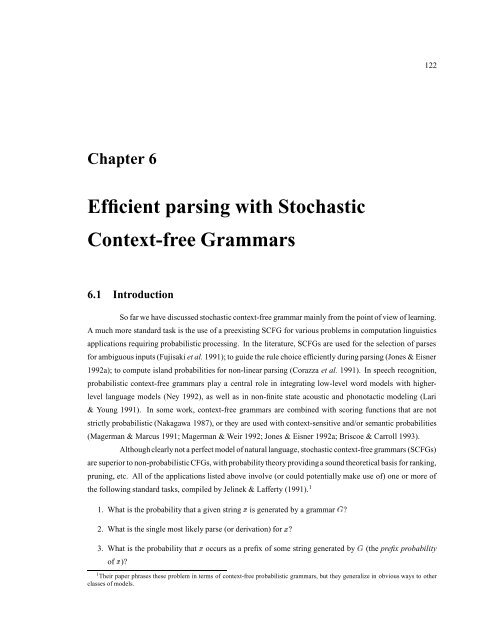The dissertation of Andreas Stolcke is approved: University of ...
The dissertation of Andreas Stolcke is approved: University of ...
The dissertation of Andreas Stolcke is approved: University of ...
- No tags were found...
Create successful ePaper yourself
Turn your PDF publications into a flip-book with our unique Google optimized e-Paper software.
122Chapter 6Efficient parsing with StochasticContext-free Grammars6.1 IntroductionSo far we have d<strong>is</strong>cussed stochastic context-free grammar mainly from the point <strong>of</strong> view <strong>of</strong> learning.A much more standard task <strong>is</strong> the use <strong>of</strong> a preex<strong>is</strong>ting SCFG for various problems in computation lingu<strong>is</strong>ticsapplications requiring probabil<strong>is</strong>tic processing. In the literature, SCFGs are used for the selection <strong>of</strong> parsesfor ambiguous inputs (Fuj<strong>is</strong>aki et al. 1991); to guide the rule choice efficiently during parsing (Jones & E<strong>is</strong>ner1992a); to compute <strong>is</strong>land probabilities for non-linear parsing (Corazza et al. 1991). In speech recognition,probabil<strong>is</strong>tic context-free grammars play a central role in integrating low-level word models with higherlevellanguage models (Ney 1992), as well as in non-finite state acoustic and phonotactic modeling (Lari& Young 1991). In some work, context-free grammars are combined with scoring functions that are notstrictly probabil<strong>is</strong>tic (Nakagawa 1987), or they are used with context-sensitive and/or semantic probabilities(Magerman & Marcus 1991; Magerman & Weir 1992; Jones & E<strong>is</strong>ner 1992a; Br<strong>is</strong>coe & Carroll 1993).Althoughclearly not a perfect model <strong>of</strong> natural language, stochastic context-free grammars (SCFGs)are superior to non-probabil<strong>is</strong>ticCFGs, with probabilitytheory providinga sound theoretical bas<strong>is</strong> for ranking,pruning, etc. All <strong>of</strong> the applications l<strong>is</strong>ted above involve (or could potentially make use <strong>of</strong>) one or more <strong>of</strong>the following standard tasks, compiled by Jelinek & Lafferty (1991). 11. What <strong>is</strong> the probability that a given string <strong>is</strong> generated by a grammar{?2. What <strong>is</strong> the single most likely parse (or derivation) for 1 ?3. What <strong>is</strong> the probability that 1 occurs as a prefix <strong>of</strong> some string generated by{ (the prefix probability<strong>of</strong> 1 )?1 <strong>The</strong>ir paper phrases these problem in terms <strong>of</strong> context-free probabil<strong>is</strong>tic grammars, but they generalize in obvious ways to otherclasses <strong>of</strong> models.1
















